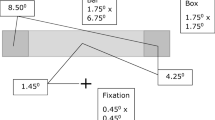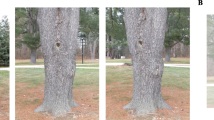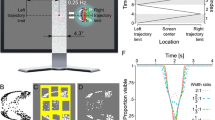Abstract
Two experiments examined the role of occlusion in reducing perceived multistability in computergenerated point-light walker displays. In Experiment 1, it was found that point-light walker displays lacking occlusion were perceived as multistable and that the addition of occlusion served to reduce this perceived ambiguity. In Experiment 2, it was found that occlusion served two functions in the perception of point-light walker displays: specifying depth order and indicating the presence of implicit occluding forms. These results are discussed in relation to contemporary motion information processing models. All existing models rely solely on the motion and topographical information present in our nonoccluding display; in so doing, these models prove inadequate, since they seek to derive unique perceptions from information seen by observers as being multistable. The findings from the present experiments demonstrate that observers utilize occlusion to reduce multistability, and, thus, rules for processing this information, and/or other forms of constraining information, need to be added to existing motion information processing models.
Article PDF
Similar content being viewed by others
Avoid common mistakes on your manuscript.
References
Aggarwal, J. K., &Martin, W. N. (1981). Analyzing dynamic scenes containing multiple moving objects. In T. S. Huang (Ed.),Image sequence analysis. Berlin: Springer.
Andersen, G. J., &Braunstein, M. L. (1983). Dynamic occlusion in the perception of rotation in depth.Perception & Psychophysics,34, 356–362.
Attneave, F. (1971). Multistability in perception.Scientific American,225, 62–71.
Bertenthal, B. I., & Kramer, S. (1984). The TMS 9918A VDP: A new device for generating moving displays on a micorocomputer.Behavior Research Methods, Instruments, & Computers, in press.
Braunstein, M. L. (1983). Perception of rotation in depth: The psychophysical evidence. InMotion: Representation and perception (ACM SIGGRAPH/SIGART Interdisciplinary Workshop). New York: Association for Computing Machinery.
Braunstein, M. L., Andersen, G. J., &Riefer, D. M. (1982). The use of occlusion to resolve ambiguity in parallel projections.Perception & Psychophysics,31, 261–267.
Cutting, J. E. (1978). A program to generate synthetic walkers as dynamic point-light displays.Behavior Research Methods & Instrumentation,10, 91–94.
Cutting, J. E., &Kozlowski, L. T. (1977). Recognizing friends by their walk: Gait perception without familiarity cues.Bulletin of the Psychonomic Society,9, 353–356.
Cutting, J. E., &Proffitt, D. R. (1981). Gait perception as an example of how we may perceive events. In R. Walk & H. L. Pick, Jr. (Eds.),Intersensory perception and sensory integration. New York: Plenum.
Cutting, J. E., &Proffitt, D. R. (1982). The minimum principal and the perception of absolute, common, and relative motions.Cognitive Psychology,14, 211–246.
Cutting, J. E., Proffitt, D. R., &Kozlowski, L. T. (1978). A biomechanical invariant for gait perception.Journal of Experimental Psychology: Human Perception and Performance,4, 357–372.
Gibson, J. J., Kaplan, G. A., Reynolds, H. N., &Wheeler, K. (1969). The change from visible to invisible: A study of optical transition.Perception & Psychophysics,5, 113–416.
Hoffman, D. D., &Flinchbaugh, B. E. (1982). The interpretation of biological motion.Biological Cybernetics,42, 195–204.
Johansson, G. (1973). Visual perception of biological motion and a model for its analysis.Perception & Psychophysics,14, 201–211.
Johansson, G. (1976), Spatio-temporal differentiation and integration in visual motion perception.Psychological Research,38, 379–396.
ba]Metzger, W. (1934). Tiefenerscheinungen in optischen Bewegungsfeldern.Psychogische Forschung,20, 195–260.
O’rourke, J., &Badler, N. I. (1980). Model-based image analysis of human motion using constraint propagation.IEEE Transactions on Pattern Analysis and Machine Intelligence,PAM1-2, 524–536.
Proffitt, D. R. (1981).Kinetic and proximity influences on perceiving structure in revolving point-lights. Paper presented at 22nd Annual Meeting of the Psychonomic Society, Philadelphia.
Proffitt, D. R. (1983).Factors affecting multistability in moving pointlight displays. Paper presented at 24th Annual Meeting of the Psychonomic Society, San Diego.
Proffitt, D. R., &Cutting, J. E. (1980). An invariant for wheelgenerated motions and the logic of its determination.Perception,9, 435–449.
ba]Restle, F. (1979). Coding theory of the perception of motion configurations.Psychological Review,86, 1–24.
Rubin, E. (1921).Visuell wahregenomenne Figuren. Copenhagen: Gyldendalske.
Ullman S. (1979).The interpretation of visual motion. Cambridge, MA: M.I.T. Press.
Wallach, H., &O’connell, D. N. (1953). The kinetic depth effect.Journal of Experimental Psychology,45, 205–217. (Also in H. Wallach, On perception. New York: Quadrangle, 1976)
ba]Webb, J. A., &Aggarwal, J. K. (1982). Structure from motion of rigid and jointed objects.Artificial Intelligence,19, 107–30.
White, B. J., &Mueser, G. E. (1960). Accuracy in reconstructing the arrangement of elements generating kinetic depth displays.Journal of Experimental Psychology,60, 1–11.
Author information
Authors and Affiliations
Additional information
This research was supported by NICHD Grant HD-16195.
Rights and permissions
About this article
Cite this article
Proffitt, D.R., Bertenthal, B.I. & Roberts, R.J. The role of occlusion in reducing multistability in moving point-light displays. Perception & Psychophysics 36, 315–323 (1984). https://doi.org/10.3758/BF03202783
Received:
Accepted:
Issue Date:
DOI: https://doi.org/10.3758/BF03202783




